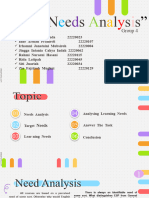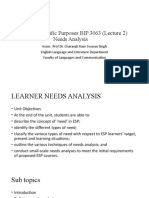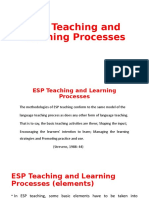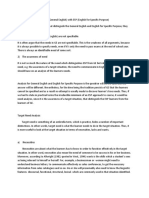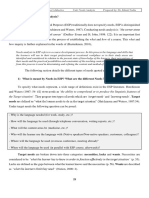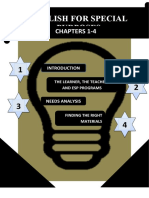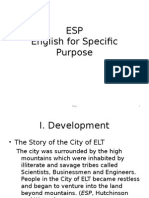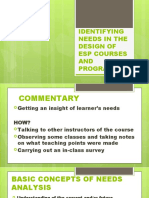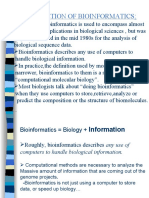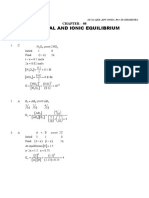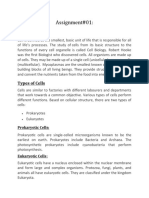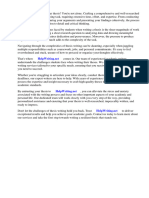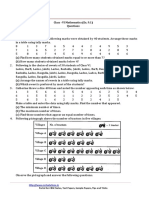ESP for
Program
Development
M. Arbain, M.Pd
�ESP for
Program
Development
Needs Analysis
�The Distinguish between GE
(General English) with ESP
(English for Specific
Purpose)
�GE Versus ESP
There are two points that distinguish the
General English and English for Specific
Purpose, they are:
1) The need of GE (General English) are
not specifiable
2) The awareness of need
�1) The need of GE (General
English) are not specifiable
It is often argue that the needs in GE are
not specifiable. This is the weakness of all
arguments, because it is always possible
to specify needs, even if it’s only the need
to pass exams at the end of school year.
There is always an identifiable need of
some sort.
�2) The awareness of need
It is not so much the nature of the need
which distinguishes ESP from GE but
rather the awareness of a need, e.g. the
awareness of a target situation, the need
to communicate in English. Thus, any
course should base on an analysis of the
learners needs.
�Analysis for General English and English
for Specific Purpose is the question will be
the same but the answer will be different.
Nevertheless, for the time being the
tradition persists of GE that the learners
cannot be specified and as a result no
attempt is usually made to discover
learner’s true needs.
�Thus, if we had to state in practical terms
the irreducible minimum of an ESP
approach to course, it would be need
analysis, since it is the awareness of a
target situation, that distinguish the ESP
learners from the learners of GE.
�Target Need Analysis
Target need is something of an umbrella
term, which is practice, hides a number of
important distinctions. In other words,
target need is what the learner needs to
do in the target situation. Thus, it is more
useful to look at the target situation in
terms of necessities, lacks and wants.
�a) Necessities
Necessities are about what the learners
has to know in order to function effectively
in the target situation. In other word,
necessities also mean the need of
someone to be successful in his or her
business. Moreover, according to Allwright
(1982, quoted in West, 1994) wants is the
skills which a student’s sees as being
relevant to himself or herself.
� For, example, a businessman or -woman
might need to understand business
letters, to communicate effectively as
sales conferences, to get the necessary
information from sales catalogues and so
on. He or she will presumably also need to
know the linguistic features- discoursal,
functional, structural, lexical- which are
commonly used in that situation identified.
� Thus, observing the situation
the learner will need to
function and then analyzing
the constituent parts of them
is important in order to now
the necessities of the learners.
�b) Lacks
Lack is the difference between the student’s
present competence and the desire
competence (Allwright 1982, quoted in
West, 1994). Moreover, based on English for
Specific Purpose book lack is about what the
learner knows already, so that the teacher
or the facilitator can decide which of the
necessities the learner’s lack (Hutchinson,
Waters and Breen, 1979 page: 56).
�c) Wants
According to Allwright 1982, quoted in West,
1994 wants is those needs on which students
put a higher priority in the available, limited
time). Moreover, according to Hutchinson and
Waters (1987) definition of wants is perceived
of subjective needs of learners. Wants also
means that the students need to know what
they want to be learned. From that situation,
students will do some efforts to achieve their
willing.
�Gathering Information
about Target Need
The analysis of target situation needs is in
essence a matter of asking question about
the target situation and the attitude
towards that situation of the various
participants in the learning process.
�Cont.
There are some ways in which information
can gathered about needs. The most
frequently used:
Questioners
Interviews
Observation
Data Collection (e.g: gathering text)
target profile of language skills
ONGOING, e.g regular class discussions.
� The simple framework
below outlines the kind of
information that the course
designer needs to gather
from an analysis of target
needs.
�A target situation analysis
framework
Why is the language needed?
for study;
for work;
for training;
for a combination of these;
for some other purpose, e.g status,
examination, promotion
�How will the language be
used?
Medium : speaking, writing,
reading, etc
Channel : e.g. telephone,
face to face
Type of text or discourse :
e.g. academic texts,
lectures, informal
conversations, technical
� What will the content areas
Subject
be? : e.g. medicine, biology,
architecture, shipping,
commerce, engineering ;
Level : e.g technician,
craftsman, postgraduate,
secondary school
�Who will the learner use the
language with?
Native speakers or non-native
Level of knowledge of receiver : e.g.
expert, layman, student;
Relationship: e.g colleague, teacher,
customers, superior, subordinate.
�Where will the language be
used?
Physical setting : e.g. office, lecture
theatre, hotel, workshop, library;
Human context : e.g alone, meetings,
demonstration, on telephone;
Linguistic context : e.g. in own country,
abroad
�When will the language be
used?
Concurrently with the ESP course or
subsequently
Frequently, seldom, in small amounts, in
large chunks
�It is clear that interpretations of needs can
vary according to the point of view of the
particular respondent. ESP like another
educational matter is concern with people
such as to all the vagaries and foibles of
human behavior. For example: in analyzing
the need of students, it would be normal
practice to ask both the lectures and the
students about their English needs.
�Learning Needs Analysis
Learning need is what the students need
to do in order to learn. Using our analogy
of the ESP course as a journey, what we
have done so far is consider the starting
point (lack) and the destination
(necessities) and where the destination
should be (wants). Moreover, the whole
ESP process is concerned not with knowing
or doing but with learning.
� We need to take into account the
destination or needs of a learning
situation: A task is enjoyable, fulfilling,
manageable, and generative.
�While, a project in class can be guided in
terms of its general orientation by the target
situation, but it specific content is a response
to learning needs. The target situation alone
is not a reliable indicator of what is needed in
the ESP course. It can determine the
destination, but we must also choose our
route: the conditions of the learning situation,
the learner’s knowledge, skills strategies, the
learner’s motivation.
� Moreover, for the example in a target situation
students may need to read long, dull, complex
texts, but their motivation may be high because:
they like the subject in general
examination are looming
job or promotion prospect may be involved
they may be going on to do very interesting
experiments or practical work based on the text
they may be like or respect the subject teacher
or boss.
�Analyzing learning needs
To analyze learning need,
we can use a similar
checklist used for target
situation analysis.
�A framework for analyzing
learning process
Why are the learners taking the course?
Compulsory or optional;
Apparent need or not
Are statuses or money, promotion involved?
What do learners think they will achieve?
What is their attitude toward ESP course?
Do they want to improve their English or do
they resent the time they have to spend on
it?
�How do the learners learn?
What is their learning background?
What is their concept of teaching and
learning?
What methodology will appeal to them?
What sorts of techniques are likely to
bore or alienate them?
�What recourse are available?
Number and professional competence of
teachers;
Attitude of teacher to ESP
Teacher’s knowledge of and attitude to
the subject content;
Materials;
Aids;
Opportunity for out-of-class activities
�Who are the learners?
Age/sex/nationality
What do they now already about English?
What subject knowledge do they have?
What are their interests?
What is their socio-cultural background?
What teaching style are they used to?
What is their attitude to English or to the
cultures of the English- speaking world?
�Where will the ESP course
take a place?
Are the surrounding
pleasant, dull, noisy, cold,
etc?
�When will the ESP course
take a place?
Time of day?
Every day/one a week;
Full time or part-time;
Concurrent with need or
pre-need.
�Conclusion
Need analysis is a complex process, involving much
more than simply looking at what the learners will
have to do in the target situation. Most of all, we
have tried to stress that both target situation needs
and learning, need must be taken into account.
Analysis of target situation needs and learning need
must be taken into account. Analysis of the target
situation can tell us what people do with language.
What we also need to know is how people learn to
do what they do with language. In order words, a
learning centered approach need analysis.






